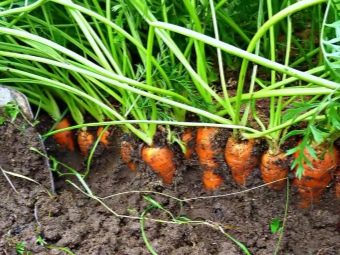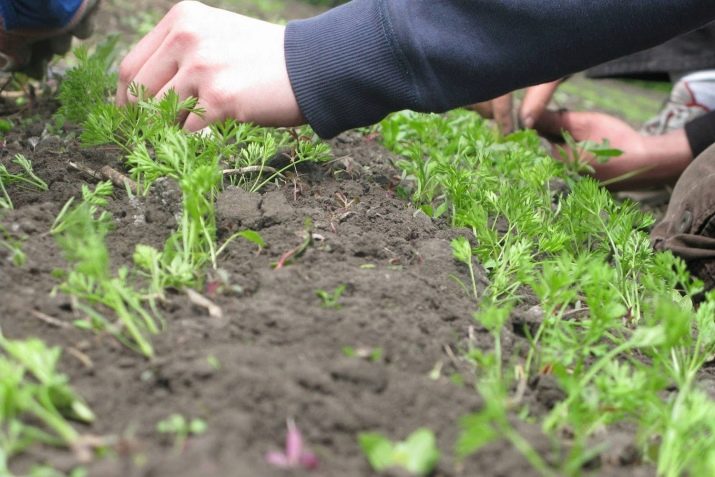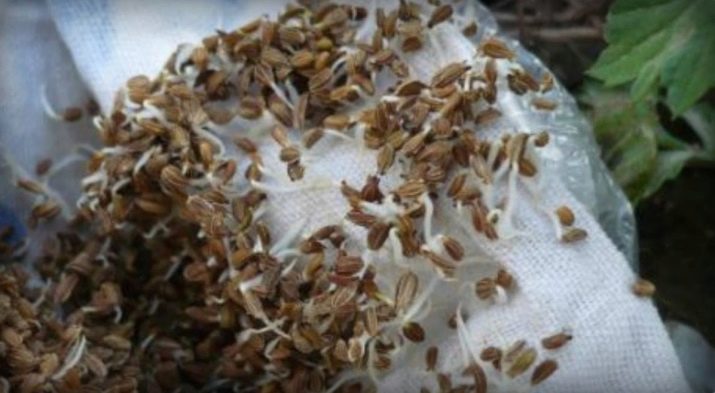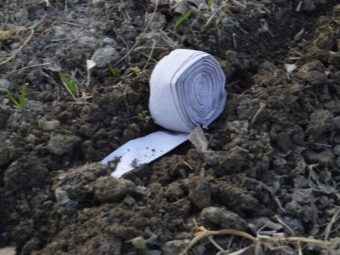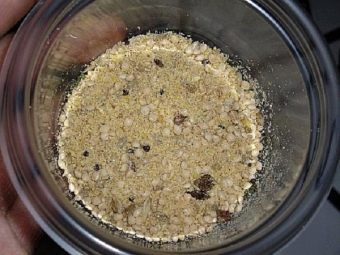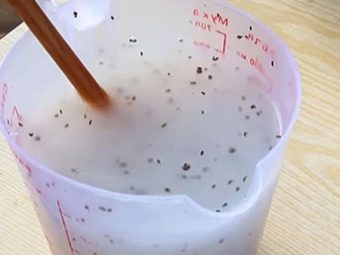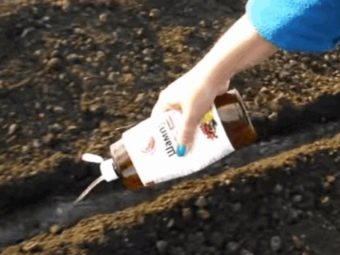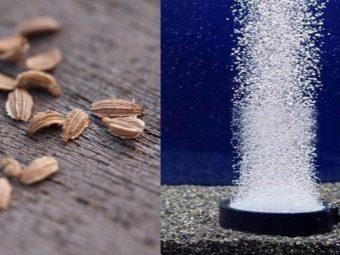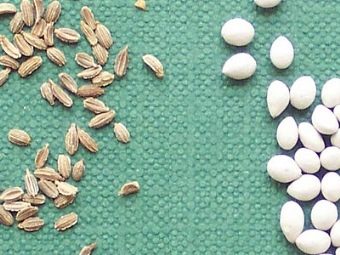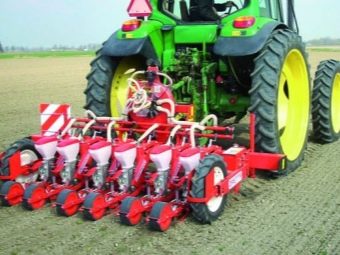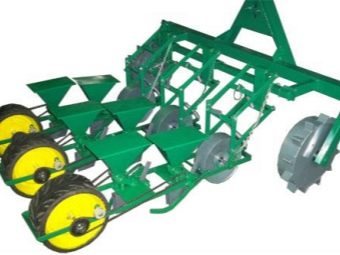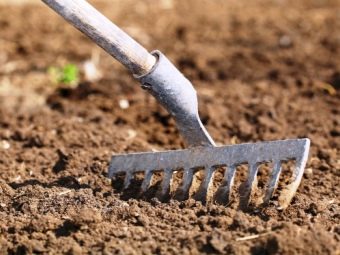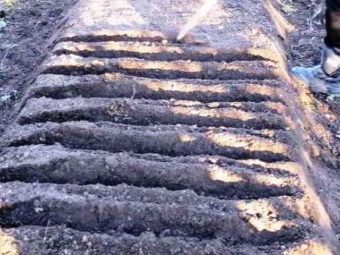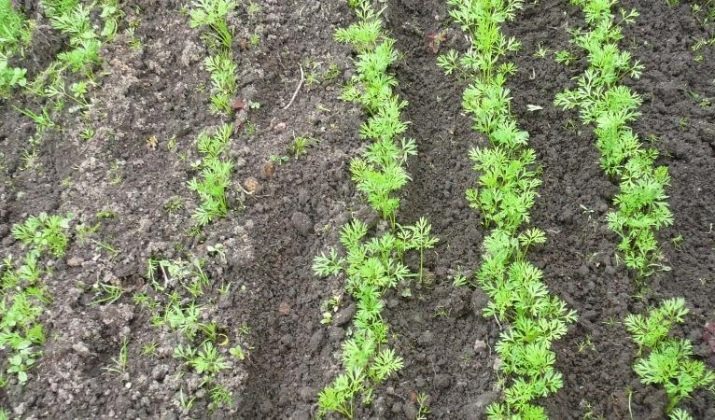How to plant carrots without further thinning?
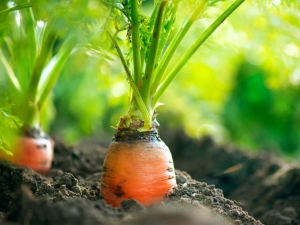
Every gardener knows that growing carrots is troublesome, and you need to work a lot to get a rich harvest. Difficulties occur in the first period of plant life and include several factors:
- Landing. Seeds of carrots are very small, they are difficult to lay out in the wells individually. Often in one place several seeds fall at once, after which the shoots turn out to be hopelessly thickened. This also adds the risk of non-spontaneous seeding into the well, which leads to an empty spot in the garden. The result is an unevenly seeded field with voids and thickened places requiring thinning.
- Thinning. The necessary time-consuming procedure in which part of the sprouted shoots is removed to make room for the most powerful shoots and allow them to fully form the root fruit.
- Weeding. The shoots of carrots are thin stalks and remain so for quite a long time. Fast-growing weeds are able to completely clog up just sprouting shoots. If you do not weed the carrots in time, then you may simply not find it among the thick grass, and the roots of weeds will take food from the soil around the tender shoots of carrots.
All these difficulties force us to look for an answer to the question of how to plant carrots correctly, in order to minimize labor costs, which require time and almost jewelry work.
Need
Seeds of carrots are weightless monochromatic grains, which are very difficult to plant by the piece. If you pour the seeds on the palm, you can make sure that a handful will look like dust. Pick up one seed from a handful, without scattering the rest, except with tweezers. That is why traditionally carrots are sown by randomly scattering seeds, and then thinning seedlings.
This method is supported by the fact that carrot seeds are often not similar. There may be several reasons for this: deformation of the seed, accidental penetration or washing out of the soil after watering. Therefore, amicable shoots are so pleasing to the eye and it is not necessary to count how many seeds have grown and where there will be holes in the garden.
However, for good nutrition and weight gain, vegetables need space and at least 5-7 cm between plants. This distance is optimal for the formation of a large fruit poured. This means that part of the closely germinated stalks will have to be removed. If this is not done, the carrot will not be able to gain strength due to the lack of trace elements. The fruits in the process of growth will interfere with each other, intertwined, the harvest will be weak and small.
It should also be borne in mind that densely grown seedlings are more at risk of bacterial and fungal diseases that are transmitted along the bed from root to root, as if by a chain. All these reasons force thinning at least two times during the growth of carrots.
The first time is thinned when the seedlings reach 2 cm from the soil surface. During the procedure, it is necessary to carefully pull out weak shoots, so as not to damage and capture the remaining ones. The plant is still very small and the root system practically does not keep them in the ground.
The second time follows the first in about a month, when the sprouts are strong enough. The main problem of the second thinning is to separate not only the stalks of carrots themselves, but also already grown and weeds and grass.
Thus, when planting carrots, the search for a method that allows you to do without thinning or at least reduce labor costs comes to the fore.
Landing methods
Popular wisdom and modern technologies offer various solutions to this problem. Despite the fact that each of the methods does not completely eliminate the need for thinning, nevertheless, it reduces the thickness of plantings by several times.
To choose the most suitable way or try out a few of them, you should familiarize yourself with the most popular methods:
- Sprouting seeds. The method is good because it is easy to separate the previously germinated carrot seeds from each other.Wet and swollen, with a clearly visible green sprout, the seeds are conveniently laid out in the grooves, clearly stand out against the background of dark soil. Seeds are soaked for several hours in room temperature water in a shallow container. Drain the water through the fabric, which will remain saturated with moisture seeds. The fabric is placed on a saucer or a plate, on top is covered with another layer - a handkerchief or gauze in several layers. A few days later, healthy seeds will sprout sprouts.
It is important to ensure that the fabric does not dry out! For hardening, the saucer is placed in a refrigerator for 7-10 days, after which the sprouts will be ready for planting in open ground.
- Paper tape In specialized stores for gardeners, you can find sowing seeds with carrot seeds. Perhaps this is one of the easiest and most convenient ways to grow carrots without thinning. The technology of planting is extremely simple: a roll with glued seeds is rolled onto the prepared wells and sprinkled with earth. Seeds are fixed at an optimal distance from each other, a narrow roll of tape allows you to make a number perfectly smooth. Thin paper will hold the seed in place, not allowing it to deepen during watering. By the time of emergence and root formation, thin paper material will dissolve in the soil.
- Tape do it yourself. When buying a ribbon, there is always a risk that some of the seeds will not be sparse, which means that the harvest will be less and the place in the garden will remain empty. To avoid this, you can make the tape yourself, after checking and preparing the seeds. However, this method will have to spend some amount of time and effort. A roll of toilet paper is perfect for this method, since it will easily disperse in the soil, and roll folding will simplify the task of applying and fixing the seeds. Glue the seeds with paste, which can be cooked with starch or flour. Having spread the paper on the free surface, it is moistened, smeared with paste, tweezers are applied to the seeds and left to dry. After that, the finished seed can be removed until spring.
- Sowing with sand. A simple and effective way of planting carrots, in which the need for thinning is markedly reduced. The essence of the method is to mix the seeds with coarse sand in a ratio of 1: 5. You need to take a small bucket, fill up 2/3 of the sand and a tablespoon of carrot seeds. Mix well and sow with pinches into the prepared furrows by “salting”, that is, by moving your fingers as if spilling salt.
- Paste solution. For this method is prepared viscous mass of 1 tbsp. spoons of flour or starch and 1 liter of boiling water. Klester stir until smooth, until all the lumps dissolve. It is important that the mass is not too thick. After cooling, pour into the mass 1 tbsp. spoonful of seeds and mix well. Due to the iron-like structure of the paste, the seeds are located at a distance from each other and the probability of their germination decreases next to each other. Paste is poured into a plastic bottle, and then shed them grooves, distributing the liquid throughout the bed.
- Seed coating As in the case of the tape method, this method has two options: you can buy ready-made drops or make them yourself. The dragee implies wrapping the seed with a layer of some substance. Plus, this technology is that the seeds in the shell are larger, bright multi-colored balls are conveniently lowered into the hole. In addition, essential minerals are added to the shell, and the capsule itself serves as protection against diseases and pests.
At home, granules can be made using ordinary flour, adding a pinch of boric acid for disinfection. To do this, slightly moist seeds are sprinkled with flour and mixed well until lumps form. After drying, small white balls are formed, which are also clearly visible on the dark surface of the soil.
Technical devices
On the modern market of agricultural equipment you can find a huge number of devices for planting and processing of various crops, from manual feeders to mechanical units on wheels.
Manufacturers offer all sorts of carrots for every taste and wallet. They can be made with your own hands using factory technology. With the help of such mechanisms you can quickly sow carrots at the right distance from each other, saving a lot of time and effort.
Mechanical seeders are classified into three types: manual, self-propelled and trailed mechanism.
Hand drills are usually small in size, easy to hold with one hand. They operate on the principle of a syringe or roller, through the opening of which seeds are poured out. They will be useful in the farm to sow one or two beds of carrots, without going to the purchase of large mechanisms.
Self-propelled seed drills are designed for large areas, when it is problematic to sow many rows with manual tools without straightening your back. The mechanism is a device on wheels with devices for laying out the furrow and subsequent tamping of the soil. Equipped with a convenient high handle and capacity for dosed release of seeds as the drill moves. They can be either mechanical or have a front or rear walk-behind tractor.
The hook-on mechanism is a powerful unit which fastens to a tractor or the motor-block. It is used for sowing volumetric areas where agricultural equipment can be developed.
Training
Before you start planting carrots in any way you like, you need to prepare the seeds and soil. This should be thought of in advance, as each of the methods of sowing has its own nuances. Preparation consists in disinfecting the seed material, as well as in checking the seed for suitability for germination.
To do this, water is poured into a small container at room temperature; several manganese beads are added before purchasing a pale pink color. Seeds are dipped in water for several hours. Empty or deformed grains will float to the surface, they are easy to remove with a teaspoon.
The soil before sowing needs to be treated, loosened and carefully removed the weed roots, otherwise with the onset of heat they will clog carrot shoots for several weeks. Weeding during the germination of carrots is extremely problematic - it is possible to damage the thin stems of a barely grown crop.
Next, the soil is prepared as for all other vegetables:
- form grooves;
- make mineral fertilizers mixed with sand, sawdust or ash;
- the grooves are well shed by a weak solution of potassium permanganate to kill the larvae of pests and fungus; Some gardeners use hot water for this.
Errors
Often, even experienced gardeners fail to avoid common mistakes when sowing carrots. There are several common ones that you should pay attention to in order to reduce the risk of getting a poor-quality crop:
- Unwillingness to remove grown shoots. This is due to the desire to grow as much fruit as possible. When the seedlings stand in a friendly row, it’s really a pity to pull out thin stalks. But it must be remembered that carrots are valuable root fruit, which over time will be little space and nutrients.
- Excessive deepening. Seeds of carrots are planted to a depth of 1.5-2 cm. Too much embedding in the soil or falling asleep with a thick layer of earth will cause the seeds to germinate too long and the fruit will not have time to ripen as much as possible in a season. There is also a risk that the seeds simply “fall asleep” and will not germinate.
- Insufficient deepening. This error usually happens when unfolding the ribbon with seeds. When powdered with ground paper, it seems that if white cellulosic material is not visible, then there is enough soil. But when watering or gusts of wind on dry soil, the tape can easily be on the surface.In this case, the seeds will dry out or the newly sprouted carrot roots will be damaged.
Tips
Do not forget about mistakes, you should also follow certain recommendations that will ease the work, reduce or refuse thinning and get a rich harvest.
To grow carrots, it is not necessary to choose an open sunny place where the earth will dry out quickly, but it is undesirable to make a bed in the shade. The optimal location is the southeastern part of the garden, where the plant will receive sunlight in the morning.
We should not forget that the methods of planting carrots without thinning do not cancel weeding! If the bed run, the weeds will quickly kill the delicate carrot growth.
When self-sticking seeds on the tape, prepare a wide comfortable table surface and a table lamp. So much easier to lay out the seeds on the paste.
In order to further reduce the need for thinning, mix the carrot seeds with radish or lettuce. Early crops will have time to give the crop before the carrots begin to pick the root fruit. By the time the carrot shoots grow up, a place in the garden will naturally become free.
Together with the carrots you can plant marigold seeds. These beautiful orange flowers will not only prevent weeds, but also scare away the carrot fly.
On how to plant carrots, see the following video.



